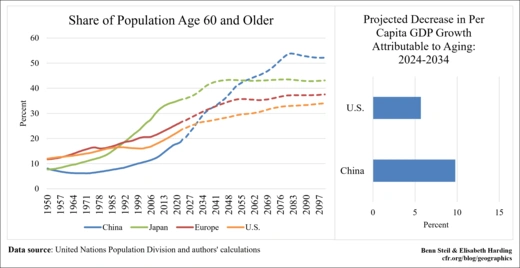Aging Will Hit China’s Economy Far Harder Than Is Recognized
The media has widely noted the drag on economic growth caused by population aging in Asia, Europe, and North America. Aging reduces the labor force participation rate, which in turn dampens GDP growth. But aging also drags down growth further through a second channel—one which is not widely recognized: that is, it pulls down labor force productivity.
On the basis of metrics from a recent study on U.S. aging, and another on aging in China, we estimate the impact of projected aging, shown in the lefthand graphic above, on GDP growth over the coming decade. Aging will not merely reduce growth for these two nations as a whole, but reduce it significantly on a per capita basis.
More on:
Our calculations are shown in the graphic to the right. As can be seen, aging will hit China considerably harder than it will the United States. Whereas aging will result in per capita U.S. GDP growth 6 percent lower than it would be without aging, it will knock a much larger 10 percent off China’s per capita growth. The gap owes mainly to China’s much lower birth rate and immigration flows.
China’s policy challenges in heading off such a steep decline in GDP growth are, correspondingly, much greater than those faced by the United States. Boosting fertility via financial incentives is expensive and difficult. Raising the retirement age for pension eligibility—currently 55 for women and 60 for men, compared to 67 for both in the U.S.—will be politically challenging. And China has been steadfastly unwilling to countenance increased immigration to fill the labor gap. The United States, in contrast, has historically been far more open to immigration, although public support will only be sustained if future flows come by way of legal channels—rather than unrestricted migration through the southern border.
More on:
 Online Store
Online Store

